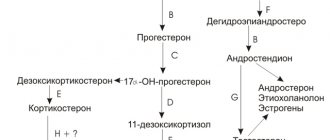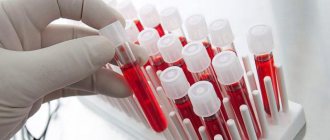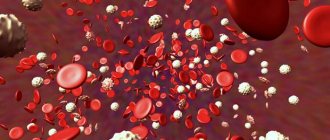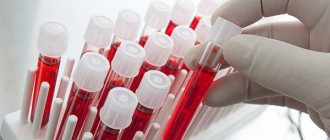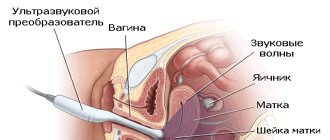When diagnosing and treating cancer, a blood test for the tumor marker CA 125 is important. It is based on identifying elevated levels of antigens in the blood, which are substances that indicate the occurrence of a tumor. Among such substances there may be some enzymes, proteins, hormones, protein products of tumor decay, etc. The CA 125 tumor marker is one of the most convenient markers, thanks to which it is possible to detect ovarian cancer based on the norm and an increase in this indicator.
The value of tumor markers
According to modern medical views, tumor markers are a group of complex protein substances that are direct products of the vital activity of tumor cells, or released by normal cells during cancer invasion.
These substances are found in biological fluids both in oncological diseases and in pathologies not related to oncology. We recommend reading: Blood test for tumor markers: types of tumor markers and interpretation of results
Remember! Detection of window markers (in particular, CA 125) in biological fluids (blood, urine) is not a 100% criterion for the presence of oncological pathology in the body. It only allows one to suspect the possibility of the onset of the disease and subsequently, using other instrumental and laboratory methods, to confirm or refute the oncological diagnosis.
It is not possible to make a diagnosis of cancer based on the presence of tumor markers alone.
ROMA Index – what is it?
In gynecology, for the differential diagnosis of cysts and ovarian cancer, a special indicator is calculated - the ROMA index (Risk of Ovarian Malignancy Algorithm). This means that when assessing the risk of a dangerous pathology, the level of two tumor markers is taken into account:
- CA-125 – specific antigen of the uterine mucosa;
- HE4 (Human epididymis protein 4) is a chemiluminescent antigen.
It is also useful to read: What to do if an ovarian cyst hurts
HE4 is synthesized by various tissues, including the epithelium of the reproductive organs and the respiratory tract. Studies have shown that high levels of chemiluminescent antigen favor ovarian carcinoma. Detection of this marker in combination with CA-125 solves the main problem of early cancer diagnosis – the nonspecificity of the test. The CA-125 antigen grows not only in malignant tumors, which significantly complicates the doctor’s work. A simultaneous increase in HE4 allows us to speak with great confidence about ovarian cancer.
In modern gynecology, HE4 is considered the best marker for diagnosing malignant neoplasms of the appendages. False-positive results are observed mainly in renal failure. In women with creatinine levels above 115 µmol/L, the results should be interpreted with the participation of a nephrologist.
The indication for a test for the ROMA index is the identification of any space-occupying formation in the pelvis. The analysis takes into account not only the level of specific proteins, but also the reproductive status of the woman. The ROMA index is actively used in premenopausal and postmenopausal women and allows diagnosing ovarian cancer with high reliability.
When identifying space-occupying ovarian formations, the ROMA index allows one to determine the degree of malignancy of the process.
Preparation for the study is standard. It is recommended to refrain from eating 4 hours before taking blood, not to drink alcohol the day before, and not to smoke an hour before the procedure. Blood for testing is taken from a vein. The results are interpreted by a doctor.
Normal values:
- ROMA1 (premenopause) – less than 7.4%;
- ROMA2 (postmenopause) – less than 25.3%.
It is important to know
A high ROMA index in the presence of a tumor in the pelvis most likely indicates ovarian cancer.
The algorithm for calculating the ROMA index is not defined for women under 18 years of age. The test is not performed on patients undergoing chemotherapy.
What does CA 125 mean?
Tumor marker CA 125 is a specific marker that helps diagnose ovarian cancer pathology at the earliest stage.
Important! The threshold or discriminatory level of CA 125 in blood plasma in women is up to 35 units/ml. In healthy men (average) – up to 10 units/ml
CA 125 is a complex compound of protein and polysaccharide.
It is an antigen of a certain type of epithelium (fetal tissue), but is present normally:
- In the tissue of the unchanged endometrium and uterine cavity in the composition of mucinous and serous fluids, but never enters the blood plasma while maintaining biological barriers.
- Minimal amounts of CA 125 are produced by the mesothelial lining of the pleura and peritoneum, the epithelium of the pericardium, bronchi, testes, fallopian tubes, gall bladder, intestines, pancreas, stomach, bronchi, and kidneys.
- An increase in the level of discrimination in women is possible in the first trimester of pregnancy and during menstruation.
Indications for testing
Women over 40 years of age are at risk for morbidity, especially during menopause. It is necessary to undergo diagnostics once a year, because... In the early stages, cancer is asymptomatic. The risk group includes women who have not given birth, as well as those with a large number of miscarriages and abortions, with diseases of the endocrine system and genetic predisposition.
For preventive purposes, it is recommended to take this test for people living in unfavorable environmental conditions. And also for people working in hazardous industries and suffering from precancerous conditions. In addition, diagnosis is carried out for cancer patients to monitor the success of treatment and identify metastases.
The level of antigen in the blood depends on the menstrual cycle; the study is carried out 2-3 days after the end of menstruation (during bleeding the level will be higher than normal). During pregnancy, the level also increases, especially in the first trimester.
Increased caffeine consumption will reduce the indicator, therefore, at least 24 hours before you need to eliminate coffee and products containing it . Various medications can also distort the results. It is necessary to notify your doctor in advance about taking any medications.
Analysis results for CA 125: decoding
If during your examination you were found to have an increase in the content of the CA 125 tumor marker above 35 units/ml, then again, do not panic and “give up on yourself.” It is important to undergo additional examination to identify the reasons for the increase in marker concentration.
Clinical data show that exceeding the discriminatory level of SA is associated with a number of non-oncological diseases, including:
- Endometriosis – 84%
- Cystic changes in the ovaries – 82%
- Inflammation of the uterine appendages – 80%
- Dysmenorrhea – from 72 to 75%
- Group of predominantly sexually transmitted infections – 70%
- Peritonitis, pleurisy, pericarditis – 70%
- Liver cirrhosis and hepatitis, long-term chronic pancreatitis - from 68 to 70%
All of the above diseases can increase the level of SA up to 100 units/ml, which is a kind of threshold for the absence of malignant neoplasms in the body.
Decoding the results
The blood is sent to the laboratory for testing. High professionalism is required from a specialist. The care with which the analysis is deciphered eliminates the possibility of error and allows timely capture of the tumor development process.
The interpretation of the analysis is ambiguous and can only be carried out by a specialist . There is no need to worry too much if the antigen level is elevated. Many chronic diseases increase CA-125 levels above normal.
It is unacceptable to independently diagnose yourself and conduct similar studies in paid laboratories, deciphering the results from reference books. Any mistake in making such a serious diagnosis, made by an amateur, can lead to mental disorder.
In the table by age, the hormonal antigen does not change its value.
The only period of life when a glycoprotein can reach borderline values due to:
- A sharply changing hormonal background of a woman is menopause.
- Antigen levels also increase during pregnancy.
- During menstruation, protein enters the bloodstream from the endometrium and uterine lining and also increases levels.
CA 125 values in cancer
Results of analyzes of the SA marker over 100 units/ml . – an alarming factor that makes one suspect the development of malignant neoplasms in the body and resort to additional diagnostic measures.
Remember! If there are high levels of the SA marker, tests are repeated, and often more than once. As a result, the results obtained specifically in dynamics are evaluated, which allows us to obtain a more reliable picture.
The tumor marker CA 125 is not a strictly specific marker, produced only in ovarian cancer.
It also occurs in such types of tumors as:
- malignant tumors of the ovaries, endometrium, fallopian tubes – 96-98%;
- malignant neoplasms of the breast – 92%;
- pancreatic cancer – 90%;
- malignant tumors of the stomach and rectum – 88%;
- lung and liver cancer – 85%;
- other types of malignant neoplasms – 65-70%
Please note: repeated high values of the CA 125 marker with increasing values over time are an alarming factor for a wide range of malignant tumors. This should direct the doctor to the most thorough search in order to establish an accurate diagnosis and for this it is necessary to use any informative examination methods.
Do not engage in self-diagnosis and self-medication, consult a specialist.
You will receive more detailed information about the importance of tumor markers, in particular the CA 125 marker, in the early diagnosis of cancer by watching this video:
Therapist, Sovinskaya Elena Nikolaevna.
163, total, today
( 58 votes, average: 4.00 out of 5)
Biopsy studies: how is a biopsy done?
Types and complications of medical abortion
Related Posts
Rules for taking a tumor marker test
The accuracy of the test results largely depends on the equipment used to determine the exact concentration of the antigen in the blood. However, there are a number of conditions that must be met during the study, which help to obtain the most reliable result:
- You should not eat before the test; you can eat your last meal 8-12 hours before the test.
- Approximately three days before taking the test, you must stop smoking and drinking alcohol.
- 8 hours before the test you need to stop drinking tea, coffee and other drinks.
- 3-4 days before taking the test, you should limit or completely stop physical activity, refuse massage and physiotherapeutic procedures.
- The day before the test, it is recommended to exclude fried, salty, smoked, and fatty foods from the diet.
- Before the test, you need to put your psycho-emotional level in order - don’t worry, don’t be nervous, don’t get upset.
- If you are taking any medications, you must notify your doctor; you may have to stop taking them during the test.
If the above rules are followed, the woman will no longer need to be tested again to ensure that the result is correct.
Note! The average cost of testing for the CA 125 tumor marker is 700-800 rubles.
The study should be carried out in the morning - between 7 and 11 o'clock. The waiting time for results can vary from one day to a week depending on the clinic where the test was performed.
What are tumor markers?
All kinds of neoplasms that arise in the human body begin to produce certain molecules. Usually these are protein molecules. They are called tumor markers. In a healthy body they are present in very limited quantities, but with the appearance of a tumor their number begins to increase. That is, tumor markers are either a product of the production of cancer cells or a reaction to the tumor of neighboring cells. The ideal tumor markers are those that are highly sensitive to a specific type of tumor. They are also called specific tumor markers.
Interpretation of analyzes
Tumor markers are deciphered by a qualified doctor. Under no circumstances should you try to figure out the indicators on your own, much less make any diagnoses for yourself.
In different laboratories, deciphering the result can take from 1 to 10 days, and the results in different clinics may differ slightly, so a repeat test must be taken where it was taken the first time.
Before deciphering, it is important to provide the doctor with as much information as possible about yourself, since the PSA tumor marker can “jump” after sexual intercourse, the concentration of CA-125 depends on the day of the menstrual cycle, AFP increases in pregnant women, and CEA in smoking women. At different ages there may be different norms; during menopause, metabolic processes slow down, and therefore the reliability of the study on tumor markers decreases.
We recommend reading Tumor marker for intestinal cancer - which one to take, interpretation, preparation
Normal tumor markers
The level of tumor markers in the blood of women can be normal, borderline, or high, indicating cancer. The table of normal values for various tumor markers in women is as follows:
- MSA (mucin-like cancer-associated antigen) – 11 IU/ml;
- hCG (human chorionic gonadotropin) – 5 IU/ml;
- AFP (alpha fetoprotein) – 15 IU/ml;
- NSE (neuron-specific enolase) – 15 ng/ml;
- CEA (carcinoembryonic antigen) – 5 ng/ml;
- CA 15-3 – 22 IU/ml;
- CA 125 – 35 IU/ml;
- SCC – 2.5 ng/ml.
Normal indicators cannot absolutely guarantee that a woman does not have pathology. If there is a suspicion of cancer, the doctor resorts to additional diagnostic methods, such as X-rays, MRI, CT, and ultrasound. A normal level of tumor markers in a woman after cancer treatment has been carried out indicates recovery.
Deviations
When studying tumor markers, the reasons for the increase can be both oncological and non-oncological. SCC may increase in diseases of the respiratory system that are inflammatory in nature. An increase in alpha-fetoprotein often indicates pregnancy, as well as kidney and liver pathology. HCG is produced by fetal cells and is therefore used to determine pregnancy. An increase in CA 15-3 occurs with a benign neoplasm in a woman’s breast (mastopathy). CA 72-4 may increase with liver cirrhosis, ovarian cysts, and pancreatitis.
During pregnancy, during menstruation, as well as in women with cirrhosis and pancreatitis, the level of CA 125 may increase. An increase in carcinoembryonic antigen occurs in smokers, pregnant women, as well as women with cirrhosis, hepatitis or tuberculosis. The HE-4 antigen increases with menopause, uterine fibroids, smoking and ovarian cysts. CA 27-29 increases in women with an inflammatory process in the mammary glands, for example, with mastitis or lactostasis.
Preparation for the event
It is important not only to know the list of oncology tests that women need to undergo, but also to follow the prescribed rules. Otherwise, the results may be erroneous. Preparation for studies aimed at identifying tumor markers in blood and urine consists of following the following recommendations:
- 3 days before the appointed date, avoid alcohol and cigarettes, use of medications and herbs.
- The time interval between the last meal and the test must be at least 3 hours. You can drink still water.
- Before performing the analysis, ensure yourself proper rest and bring your psycho-emotional state back to normal.
- For 7 days, junk food is excluded from the diet.
Tests are taken in the first half of the day, and it is forbidden to eat food before the procedure.
Tests are taken on an empty stomach in the first half of the day - from 8 to 12 o'clock. Be sure to take into account the day of your cycle. The most suitable time for visiting the laboratory is its initial phase. After surgery, blood is donated more often, because the doctor must understand whether there is a need for additional chemotherapy and radiotherapy.
Indications for use
Tumor marker tests are performed on patients undergoing chemotherapy and radiation to monitor treatment.
Tests for tumor markers in gynecology are not prescribed to everyone, but only to those whose health is of concern and who have already been prescribed cancer treatment. The patient may be recommended to undergo them along with other studies to exclude serious pathologies in case of disruption of the normal functioning of the body, or to undergo them for prevention. Cancer screening is performed to confirm the diagnosis and monitor the results of chemotherapy or radiation.
Every year you should have a cervical smear and tests for breast tumor markers.
Causes of ovarian cysts
The physiological process of the appearance of ovarian cysts is not fully understood. Scientists claim that the occurrence of pathology occurs due to a malfunction in hormonal spherules, inflammatory processes and apoptosis (programmed cell death).
Ovarian cysts are observed in 8% of women of puberty, including menopause. The manifestation of a cyst is associated with the monthly cycle, regardless of age and health. After menopause, the cyst rarely appears. When the cyst is supported by risk factors: sexually transmitted infection, late menopause, stress, smoking, early monarchy, tumor complications, decreased fertility, infertility, miscarriages are possible.
In the presence of an adnexal cyst, there is an increase in the number of Ca 125 tumor markers. This disease requires a special approach and treatment, since there is a transition from a cyst to cancer.
Women of climatic age should regularly take a Ca 125 test to reduce the risk of tumor development. This applies to patients even after cyst removal. If the level of tumor markers is exceeded after menopause, this serves as a serious signal for a thorough examination. An analysis for Ca 125, after menopause, must be taken annually.
Interpretation of blood test parameters for tumor markers
Alpha fetoprotein
AFP is a serum fetal protein produced in the embryo and fetus during growth and development. The structure of the protein is similar to serum albumin in adults. Its main function is to prevent the mother's body from rejecting the fetus. At birth, children have the highest level of AFP in the blood, then it progressively decreases and by 2 years it reaches normal adult values. An increase in alpha protein levels in adults may indicate the presence of pathologies.
Increased AFP levels may indicate multiple pregnancy
AFP is one of the main indicators of chromosomal abnormalities and pathologies during fetal development. During pregnancy, protein level testing is often carried out in conjunction with determining the level of free estriol, human chorionic gonadotropin and ultrasound, which makes it possible to assess the risks of developing pathologies in the fetus.
An increase in AFP levels in women during pregnancy can be a sign of multiple pregnancy, fetal liver necrosis due to a viral infection, Meckel-Gruber syndrome, umbilical hernia, open defects in the development of the neural tube.
For men and non-pregnant women, an AFP test is usually indicated to assess the effectiveness of treatment of malignant neoplasms, detect metastasis, and determine the risk of developing cancer in patients with liver cirrhosis, chronic viral hepatitis and other diseases.
If the patient is taking medications, he needs to consult with his doctor whether there is a need and possibility of discontinuing them.
An increase in protein levels in non-pregnant women, as well as in men, is observed against the background of neoplasms of the large intestine, pancreas, stomach, lungs, testicles, liver metastases of tumors of other localizations, and hepatocellular carcinoma. A slight increase in the indicator is observed in alcoholic liver damage, cirrhosis, and chronic hepatitis.
A decrease in AFP levels after a course of therapy or removal of a tumor means an improvement in the patient's condition. During pregnancy, a decrease in the level of protein in the blood may indicate the presence of chromosomal pathologies in the fetus (Down or Edwards syndrome), hydatidiform mole, as well as spontaneous abortion, fetal death, or an incorrectly determined gestational age (overestimated).
Carcinoembryonic antigen
CEA is an embryonic glycoprotein produced in the tissues of the digestive tract of the embryo and fetus. Its main function is related to the stimulation of cell reproduction. Glycoprotein synthesis is suppressed after the birth of a child; in adults, its concentration in the blood is insignificant. In cases of tumor development in the body, an increase in carcinoembryonic antigen occurs, which reflects the progression of the pathological process.
A blood test for CEA is necessary when assessing ongoing therapy for stomach cancer.
A blood test for CEA is done when assessing ongoing cancer therapy, diagnosing cancer of the rectum, colon, stomach, pancreas, medullary carcinoma, and is also used for early detection of malignant tumors during screening examinations of risk groups.
An increase in CEA levels not only indicates the development of cancer, but is also observed against the background of renal failure, tuberculosis, emphysema, pneumonia, cystic fibrosis, pancreatitis, liver hemangioma, cirrhosis, hepatitis, ulcerative colitis, Crohn's disease, intestinal polyposis. In these diseases, the level of fetal glycoprotein usually does not exceed 10 ng/ml.
The main advantage of blood testing for tumor markers is that it allows you to detect the disease at a time when other types of diagnostics do not yet show abnormalities.
Also, the concentration of the tumor marker may increase with metastases to bone tissue or liver, colorectal carcinoma, thyroid, prostate, pancreatic or breast cancer, liver, ovaries, and lung.
If an increase in CEA values is recorded after a decrease in its concentration in the blood, this may be a sign of tumor relapse and metastasis. It should be taken into account that drinking alcoholic beverages and smoking affect the concentration of carcinoembryonic antigen in the blood.
Ovarian tumor marker CA-125
CA-125 is a glycoprotein used as a marker for non-mucinous epithelial forms of ovarian malignancies and their metastases. In heart failure, its concentration correlates with the level of natriuretic hormone, which can serve as an additional criterion for determining the severity of the patient's condition.
CA-125 – tumor marker for ovarian tumors
A blood test for glycoprotein is prescribed during the diagnosis of pancreatic adenocarcinoma, ovarian cancer and its relapses, as well as to assess the quality of therapy and prognosis.
An increase in the concentration of CA-125 is observed against the background of malignant neoplasms of the lungs, liver, pancreas or mammary gland, stomach, rectum, fallopian tubes, uterus, ovaries. Also, an increase in glycoprotein can be recorded during menstruation, with ovarian cysts, liver cirrhosis, viral hepatitis, autoimmune diseases, inflammation in the abdominal cavity or pelvis. In the first trimester of pregnancy, the value of the tumor marker may increase slightly in the absence of any disease.
